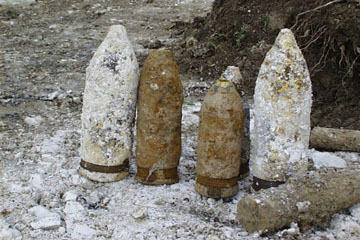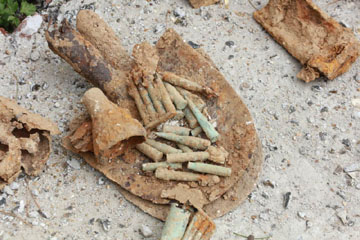100 Years Later: Construction at the Vimy Memorial
Construction projects along the First World War’s Western Front are very different than construction projects in Canada. Even 100 years later, the French and Belgian soil continues to turn up dangerous remnants and important artefacts from the First World War.
Keep reading to learn about the unique challenges overcome during the building of the Canadian National Vimy Memorial’s Visitor Education Centre.
The Iron Harvest
Stretching across France and into the Flanders area of Belgium, the Western front was the scene of some of the most intense fighting of the First World War. Between 1914 and 1918, Allied and German forces dug a thousand kilometers of trenches, strung reels of barbed wire and launched millions of shells and bombs in the area. A century later, the land still contains many long buried and sometimes dangerous reminders of the Great War.
Called the 'Iron Harvest' because many items are uncovered as farmers plough their fields, construction in France and Belgium routinely unearths rusted items like barbed wire, bullets, shrapnel and shovels. Buried shells and mortars are particularly dangerous as many failed to explode on impact and remain live. Careful planning and strict protocols are necessary to ensure safe handling of these materials.
Archaeology and Demining
The safety of workers and visitors is our top priority, which is why site preparation for our new Visitor Education Centre began long before ground was ever broken for construction.
Extensive testing on the site began in 2014 and included an environmental assessment and geotechnical studies. These investigations identified any contaminants in the soil, located underground tunnels and voids, and ensured the soil was stable enough to support the new building.
Next, bomb disposal experts from the Direction de la Défense de la Sécurité Civile safely located, removed and disposed of unexploded ordnances buried underground. Among the items removed were intact shells, live rifle cartridges, grenades, shell fragments and rifle remains.
Finally, archaeologists played an important role in project planning and monitoring the site. In addition to weapons and tools, construction can also uncover important artefacts like canteens, helmets, buttons, boots and rifles. Each tells an important story about the men and women who served.
Lost Sons
Because the Canadian National Vimy Memorial site is a preserved battlefield, the land surrounding the memorial still lays claim to soldiers lost in battle. For this reason, construction activity at Vimy is limited and is always undertaken with extreme care. Clear processes are in place to address the discovery of human remains and ensure they are treated with the utmost care, dignity and respect.
In 2014, partial remains were uncovered during site preparation for the Visitor Education Centre. Work at the site immediately stopped while a representative from the Commonwealth War Graves Commission (CWGC) documented the discovery. After carefully removing and storing the items found, the CWGC worked closely with the Canadian Armed Forces’ Directorate of History and Heritage, whose Casualty Identification Program is mandated to identify newly discovered military fatalities through the use of historical research and modern scientific methods. Unfortunately, it was not possible in this case to determine the soldier’s identity or nationality. In 2016, he was re-buried near Vimy at Brown’s Copse Cemetery. His marker identifies him as an Unknown Soldier of the First World War.
- Date modified:

